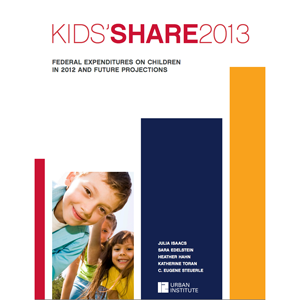 WASHINGTON – Federal outlays for children declined $28 billion, or about 7 percent, from fiscal year 2011 to fiscal 2012, the biggest year-to-year decline in three decades, says a new report.
WASHINGTON – Federal outlays for children declined $28 billion, or about 7 percent, from fiscal year 2011 to fiscal 2012, the biggest year-to-year decline in three decades, says a new report.
The report, by the Urban Institute, shows the federal outlays on children – a broad measure of funding that benefits children – decreased from $377 billion to $348 billion, the biggest drop since the early 1980s.
The report, “Kids’ Share 2013,” found more than half the cuts were to education programs, which dropped by $18 billion, or 27 percent. Federal funding for pre-school education and care fell by 12 percent, while funding for children’s healthcare and for housing each declined by 6 percent.
Advocates for children and the poor pointed out that the cutbacks, the Urban Institute’s latest figures on federal outlays for children, predated sequester spending cuts, and more sequester cuts could be on the way.
The report comes at a time when new U.S. Census figures show more than one in five American children, nearly 22 percent, lived in poverty in 2012, when the poverty threshold was $23,492 for a family of four.
Spending cuts came largely as a result of the continuing decline in federal stimulus spending under the 2009 American Recovery and Reinvestment Act, the report finds. Nearly one-fourth of the funds from the federal stimulus went toward outlays for children, including education and children’s health.
The report’s lead author, Julia Isaacs, an Urban Institute senior fellow, noted that with the sluggish economic recovery, spending on children dropped even while many families were struggling to get by.
Isaacs said the report’s findings should “highlight to Congress the needs of children haven’t fallen the way funding has fallen.”
“I’m afraid that the nation’s attention is not on child poverty and children, as if somehow the recession came and went. But the lingering effects on children are still here,” Isaacs told Youth Today.
Bruce Lesley, president of First Focus, a bipartisan advocacy group for children which commissioned the report, called the $28 billion spending reduction alarming.
“It’s a huge issue because what that really demonstrates is an enormous reduction in investments for kids, and here we’re in tough times and what we really need to be doing is making sure that we’re protecting kids, and instead we’re doing the exact opposite,” Lesley told Youth Today.
Lesley noted polls showing broad bipartisan support among voters for education and children’s programs and said Congress should take heed.
“What the public would say is that you actually should be making kids a priority,” Lesley said. “Congress is doing the opposite.”
Deborah Weinstein, executive director of the Coalition on Human Needs, told Youth Today the decline in spending had hit parents and children especially hard.
“It’s very disturbing. It should set off alarm bells,” Weinstein said. “We need to be investing so that families can have more help in raising their children while the parents try to go to work.
“And to see that there is less early-childhood education funding, that there is less education funding, that there is not anywhere near the childcare funding that we need, these all are things that are blows to the ability of parents struggling to raise their children.”
Alison Buist, director of child health at the Children’s Defense Fund, said the report reflects misplaced priorities among lawmakers.
“I mean, it really is a matter of preparing our nation for the future that we want to have,” Buist told Youth Today. “If you don’t invest in children now, there are going to be consequences down the road.”
For instance, Buist said, a lack of early-childhood programs increases chances of a child ending up in prison, while cuts to Medicaid and food stamps can lead to poor performance in school and increase the chances a girl will get pregnant as a teenager.
The report also looked ahead to 2023, and funding prospects for children’s programs appeared bleak, based on Congressional Budget Office projections.
Barring policy changes in Congress, of every dollar in increased federal spending, only 2 cents will go toward helping children, the report said. All the children’s spending increase would go toward health care, and excluding health care, less would be spent on children in 2023 than in 2012, the report said.
The report projects a 6 percent decline in early care and education spending and an 8 percent decline in spending for child nutrition programs.
























